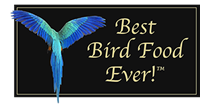Parrot Food and Behavior
Did you know that companion and aviary birds are subjected to more stresses than any other animals maintained in captivity? According to information in the avian veterinary text, Avian Medicine: Principles and Application, for birds, stresses tend to be accumulative. This means each new stressful experience is added to all the earlier ones. The problem in this is that with each new stressful experience the bird may become weakened to the point of clinical illness (where symptoms are present) or one too many stresses could result in death.
What Causes Stress?
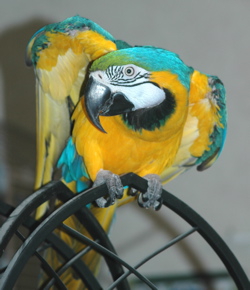
A healthy, symptom free, Blue and Gold macaw. Who LOVES to show his ‘pretty wings!
Everyone who cares for more than one bird knows that behind each inquisitive face is a unique individual with a distinctive personality, even among birds of the same species. And, along with these recognizable temperaments comes each bird’s particular way of interpreting what is stressful to them.
For one parrot having a ‘new’ person come into your home may be a fun filled, even exciting experience, a time to show off and make a spectacle of ‘pretty wings’ or ‘big eagle’. While for another parrot, this situation, may make them feel threatened. You’ll see this when they freeze, mid-movement, as if just having been spotted by a hungry predator.
There are nearly an endless number of variables that can contribute to how a parrot or finch interprets changes in their environment. Previous experiences they’ve had, level of socialization – or lack of interaction with people. Were they plucked from the wild as a nestling, or captive raised as a hand fed baby? Or have they lived as a ‘feathered ornament’, destined to be cage bound without any hope of having fun time on a playpen or an entertaining outing to a bird club meeting.
Take Notice
In your role as caretaker, it’s important to pay attention to, and make a mental note of, how each of your birds reacts to anything new in their environment. Because what may indicate fun and games to one bird, could be the ‘innocent’ misunderstanding that starts your bird down the long road of feather destruction behavior, repetitive loud screaming or another unwanted stress related behavior. Some caretakers have even witnessed a formerly gentle and loving bird become aggressive by flailing an open beak at them, in a threatening manner, while some of these birds even start biting.
.
Consider a Bird’s Environment
Some factors known to stress birds include shipping, overcrowded living conditions, unclean living conditions, malnutrition, poor ventilation, those of a very young or very old age, antibiotic therapy (particularly tetracyclines), corticosteriod administration, respiratory irritants such as disinfectant fumes, cigarette smoke, and ammonia, or concomitant disease – an underlying condition, not showing symptoms, that may adversely effect the proper and healthy functioning of the body’s metabolism. Many of the factors described here could be grouped into a larger category described as environmental stressors.(1)
.
Stress-Responses Shared Between Species
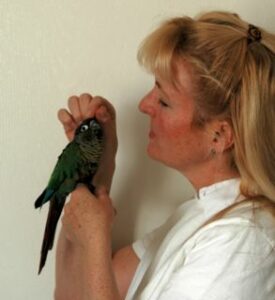
When Elvis first met me, he appeared enamored.
In birds, other animals and people the automatic, physiological, responses to stressful situations are very similar. Let’s examine this relationship more closely.
.
Stress in People
Our muscles get tense, our heart races (starts beats faster and pounding harder), our breathing speeds up as we take in more oxygen. This is how our body prepares us to either fight or run, known as the “fight or flight” syndrome.
.
Stress in Birds
Avian physiology closely resembles ours, making their response to stress much like our own. Muscles become tense, while both their breathing and heart rate increases. But what takes place in the body to prepare an individual to take on a perceived life or death situation? The body’s natural hormones jump into action.
.
The Natural Response
Hormones are the chemicals that command certain parts of the body to take action. In birds the adrenal glands produce corticosterone, their most important corticoid hormone.(1)
Corticosterone regulates nutritional metabolism and the flow of blood throughout the body. It is essential during times of stress and regulates the production and balance of other biologically active substance produced during the stress response.(1)
In people if this stress-response takes place too often, or even daily, doctors call it ‘chronic stress’. However, in birds if the stress-response is left unchecked and continues repeatedly, the stress related release of corticosterone, and the other biologically active stress induced substances would cause the animal to go into shock.(1)
During the stress-response, a bird’s body immediately starts producing higher amounts of glucose for the increased energy needs of fighting or fleeing. To fuel these accelerated energy needs, after the carbohydrates stored in the body have been depleted – this depletion occurs in about 24 hours – the body next starts breaking down its protein and fats. This is an alarming fact. It’s alarming because the way the body breaks down these proteins and fats is to start consuming the amino acids in its own skeletal muscles. This process is called gluconeogenesis.(1)
Gluconeogenesis is stimulated by corticosterone and other glucocorticoids during the avian stress-response. (3)
.
Stress Alters Nutrient Absorption
In people stress causes us to feel “butterflies” or a knot in the stomach and can even result in nausea or vomiting. When stress induced hormone flood though our body, digestion stops. In our birds when the stress-response is actively engaged their digestion is also impaired.(1)(2)
This flood of stress induced hormones and chemicals alters normal avian metabolism (the ability to breakdown and use nutrients) and adversely affects normal body maintenance levels of vitamin A, C, calcium, zinc, iron, copper and magnesium.(1)
Other essential nutrients that would not be able to be absorbed and use by the body during the stress-response include: complete protein, enzymes, the B complex vitamins, the fat soluble vitamins E and K, essential fatty acids, all antioxidants, the macro-minerals phosphorus (vital for calcium absorption), potassium, sodium and chloride, and the trace minerals selenium, manganese, cobalt, sulphur and iodine.
The avian stress-response would also throw-off the crucial calcium to phosphorus balance so important for maintaining normal and healthy functioning of the heart, muscles and nerves.
.
Stress Can Cause Disease
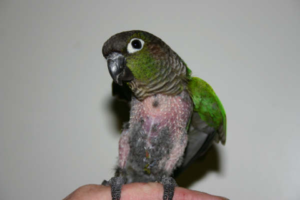
Green-checked conure exhibiting feather destruction habits. BEFORE
When a bird experiences repeated stressful events over time gluconeogenesis, the stress induced metabolic process described above causes the liver and kidneys to pump high amounts of glucose into the blood stream. This combined with the way gluconeogenesis robs proteins and fats from the body can result in numerous diseases developing in the body.(2)(3)
Long term stress, inducing gluconeogenesis, has been reported as causing diabetes, the destruction and breakdown of muscle tissue, disruption and suppression of the avian reproductive cycle, hormone imbalances, malnutrition and undernutrition – the leading cause of illness, disease and early death, and immune system suppression.(2)(3)
When a bird’s immune system has been suppressed, and can no longer function properly, this can cause a bird to contract an endless number of pathogens. This occurs because it’s not the pathogen that causes disease. It is the weakened immune system that makes the bird vulnerable to infection.
Any of the conditions described here, or a combination of these conditions, can shorten a bird’s life span causing them to die way before their time.(2)(3)
.
Replacing Stress-Depleted Nutrients
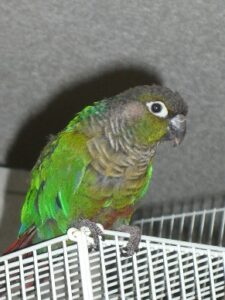
Elvis, Green-checked conure, now fully feathered. AFTER
Even though, Avian Medicine: Principles and Application, states that attempts to restore these depleted nutrients through special dietary modifications is probably useless, I disagree. I remind you that this statement come from those who uses pharmaceutical medicines to treat symptoms. These individuals do not use food and nutrition, combined with select herbs, as a primary treatment protocol for restoring good health and wellness to our parrots and finches like I do.
.
Using Food as Medicine for Good Health
My personal experience in creating personalized food plans for healing and reversing avian disease conditions has demonstrated that these depleted nutrients can be restored to the body. I make this statement because numerous birds I have worked with have become symptom-free and have been restored to good health when their caretakers have followed the balanced and wholesome personalized food plans I have created for them.
.
.
Where are your birds getting all these nutrients from?
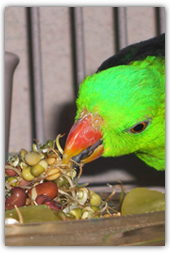
Crimson winged parrot enjoying BBFE properly grown, complete protein sprouting blend.
The next article in the, “Changing Our Bird Feeding Customs”, blog post and article series will describe how to best use balanced and wholesome avian nutrition to actively replace these stress-depleted nutrients. We’ll also focus on the foods and nutrients essential for helping your birds become better able to cope with any stresses in their environment.
MY PROMISE – I’M MAKING BALANCED & WHOLESOME AVIAN NUTRITION EASY FOR YOU! AND DELICIOUS FOR YOUR FLOCK..
.
.
.START FEEDING BBFE! TODAY SHOP OUR STORE
If you have questions or enjoyed this article, please post a comment.
To the best of health for your flock!
.
![]()
